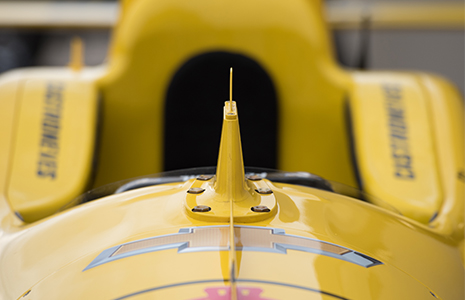INDIANAPOLIS – The NTT IndyCar Series open test Wednesday at Indianapolis Motor Speedway provided the perfect place for sanctioning body INDYCAR to unveil its latest driver safety development, the Advanced Frontal Protection debris deflector.
The small titanium piece, bolted on the Dallara chassis centerline of all cars just in front of the cockpit, is designed to push flying debris away from the driver and becomes mandatory on all entries beginning with practice for the 103rd Indianapolis 500 presented by Gainbridge and continuing through the rest of the season
The AFP weighs only 2.8 pounds but has passed the same load testing as the Indy car roll hoop that sits behind and above the driver. Explaining the benefits of the AFP on Wednesday morning, INDYCAR President Jay Frye called it the first of several phases that are planned to improve cockpit safety.
 “If a piece (of debris) comes toward the front of the nose, toward the driver,” Frye said, “this will deflect the debris away from the driver.”
“If a piece (of debris) comes toward the front of the nose, toward the driver,” Frye said, “this will deflect the debris away from the driver.”
Frye added that five-time NTT IndyCar Series champion Scott Dixon virtually tested an AFP on a racing simulator and had no issues with its implementation. Along with other items on team checklists, the open test served as the chance for drivers to become accustomed visually to the AFP.
“It’s something now that’s in front of them that wasn’t there before,” Frye said. “We’re excited to hear what they say. … It’s something they’ll have to get used to, but that’s part of what today is about.
“They know why we’re doing it. We’re doing it to help them.”
INDYCAR continues work behind the scenes on development of a windscreen. Dixon and Josef Newgarden tested a prototype last year in separate tests at ISM Raceway in Phoenix and Indianapolis Motor Speedway, but series technical and safety officials said the windscreen requires further development before it could be implemented.
“There’s a cause and effect to everything, so we wanted to make sure we vet it out before we put anything on the car,” Frye said. “That’s kind of what happened last fall with the other piece we were working on at the end. There were some things that didn’t like at the end.
“It’s an evolving process; we work on safety every day. (The AFP) is just the next evolution of what we’re doing.”
The AFP has been on INDYCAR’s radar since 2012. Including the reinforcements built into the monocoque for support, the entire unit adds less than five pounds in weight. Frye and INDYCAR are sold on its benefits.
“We have a very thorough (development) process,” Frye said. “We wouldn’t put it on a car if we weren’t confident it would do what it’s designed to do.”
And, Frye added, there’s more to come in regard to cockpit safety … soon.
“This will be Phase 1 of our solution,” he said. “Sometime in May, we’ll announce what we’re doing next.
“This is Phase 1, it’ll do X. The other things we’re working on will be Y and Z in the process.”